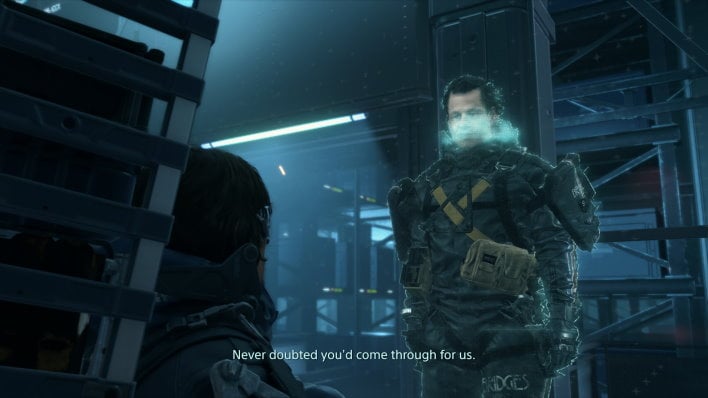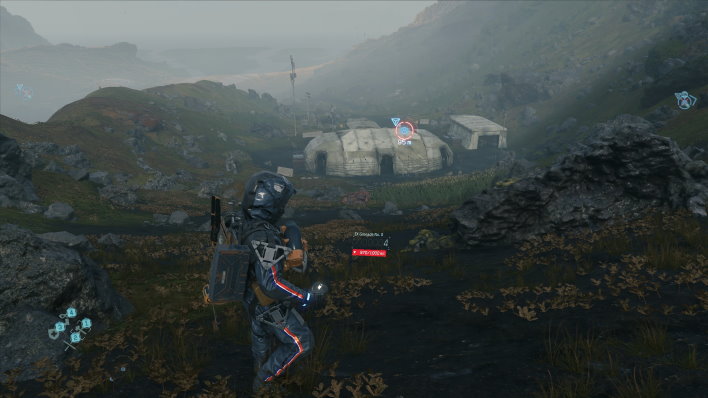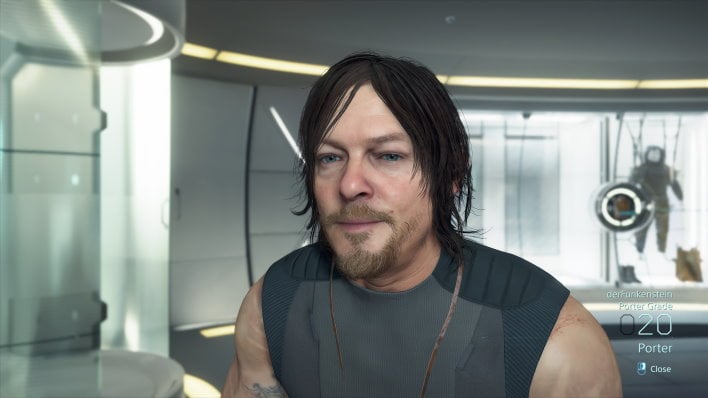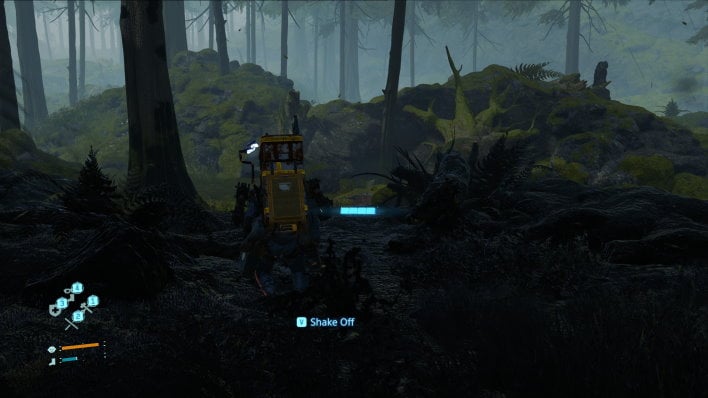Death Stranding PC Review: Transcending Gameplay To Art
Death Stranding PC Review: Kojima Off The Chain
"Once...there was an explosion." So opens the oft-memed narrative of Kojima Productions' first post-Konami title, Death Stranding. If you've not been paying attention to the game, which launched in November as a PlayStation 4 exclusive, this title is about to make its jump to the PC. On July 14, non-PS4 gamers will get their first look at a post-apocalyptic world where, if one person dies, entire cities could be close behind. We got early access to the game, and today we can tell you about our experience, which is probably best summed up as "wild."
Of Bridges And Bridges
In a near-future version of the world, a mostly-unexplained event called the Death Stranding caused a weakening of the divide between the world of the living and the land of the dead. The weakening of the divide causes invisible creatures, casually referred to as BTs (or Beached Things) to roam the land. They're usually preceded by "timefall", a form of rain that causes whatever gets wet to age rapidly. If a BT consumes a living being, they can cause a "voidout", a massive explosion that kills everything nearby.You are Sam Porter Bridges, who some call "The Great Deliverer". Others know him as a legend in the package delivery business. He's also afflicted with DOOMS, which is a condition that conveniently allows Sam to sense the presence of BTs. Sam is also a "repatriate", which means he can (handily) resurrect himself should he expire in combat. The same can't be said for the crater left by a voidout, however. This mild-mannered courier does freelance work for Bridges, a company with the goal of reuniting the fractured populace of the United States. Sam is played by Norman Reedus, who is best known as as Murphy MacManus from The Boondock Saints movies and Daryl on AMC's The Walking Dead. Reedus is a solid actor, and his skills come across in the game. If only everyone's performances were so solid.
We don't want to spoil the narrative, which YouTube and Twitch streamers have been doing for months, any more than it needs to be, but it's best to get our biggest complaint out of the way immediately: there's a ton of unnecessary talking. For example, every time Sam finishes a delivery, there's a lengthy recycled cut scene in which the recipient evaluates your performance. Occasionally those are followed by more repeated cut scenes where Sam can fix terminals in cut-off areas and connect them to the
It would be easy to make jokes about Death Stranding's gameplay. When the game was released on the PlayStation 4, memes popped up and some reviews referred to it as a walking simulator. Some of that is true; Sam is embarking on an adventure across the United States from sea to shining sea, although it's not a full-scale model. The tutorial mission involves hiking across the wilderness to deliver a package to an outpost. The game even tells us how far we walked and the (usually sub-optimal) path we took to complete the delivery. Eventually you'll unlock vehicles to make the distance go by more quickly, but regardless of the transportation mode, Death Stranding leans heavily into this "lone wolf traveling across America" motif.
Sam also falls down—a lot. It'd be just as accurate to jokingly call the game a falling simulator, but there's a very good reason for Sam's clumsiness. Remember, Sam is a courier and he's on foot, so that means he's carrying his packages in a backpack strapped to his back, and some of those packages are heavy. Early in the game before Sam's "balance" attribute really starts getting upgraded, he gets off balance by stepping on rocks and uneven terrain, crossing a river, and at one point even a sidewalk. We fell down several times just by turning too quickly. Pressing both mouse buttons gets Sam to buckle down, center his load, and regain his balance at the cost of speed.
Combat is not really a thing that happens in Death Stranding. Most of the time, we were sneaking around Metal Gear Solid style, avoiding the omniscient eye of any BTs we came across. Later on there are ways to deal with BTs more directly, but the early part of the game is very stealthy. Additional enemies do show their faces eventually, like MULEs and Terrorists, but even then, Sam seems to be above weapons and prefers hand-to-hand combat and other non-lethal means. The game isn't Stardew Valley in its passivity, but Death Stranding makes it clear that killing has consequences, since those bodies could then be turned into deadly, invisible BTs.
We're In This Together
Fortunately, Sam gets by with a little help from his coworkers. First is Deadman, former coroner turned medical doctor portrayed by a combination of Guillermo del Toro's body (best known for directing Hellboy and Blade II) and Jesse Corti's voice (LeFou in the animated Beauty and the Beast). He helps revive Sam after the first in-game encounter with a BT. Bridges director Die-Hardman (whose given name is—I kid you not—John Blake McClain, like Bruce Willis's character in Die Hard) is played by renowned voice actor Tommie Earl Jenkins. Die-Hardman initially convinces Sam to aid in reconstructing the network, and gives guidance throughout the game.The two outfit Sam with a variety of equipment, including uniforms, climbing gear, and so on. As the game progresses and Sam gets more of the country online, he can fabricate additional pieces of gear to make the journey a little bit easier, too. Creating our own ladders make seemingly insurmountable mountains a slight exercise in patience. As Sam completes main story missions, more and more crafting recipes become available. Eventually, Sam is able to craft light vehicles to carry the weight and speed up travel times. These are both welcome additions later in the game.
Early in the game, Deadman and Die-Hardman provide Sam with his BB, which is, uh...a baby in a bottle. A Bridge Baby is an unborn fetus in a glass jar "womb" that connects into Sam's uniform to aid in the detection—and therefore avoidance—of BTs. BBs help bridge the gap between the realm of the living and the dead because they come from—actually, you know what? We told you Death Stranding was wild, and there are some things you're just going to have to experience for yourself. Suffice it to say, the BB can help deal with BTs, and Sam develops a strong emotional attachment to his baby.
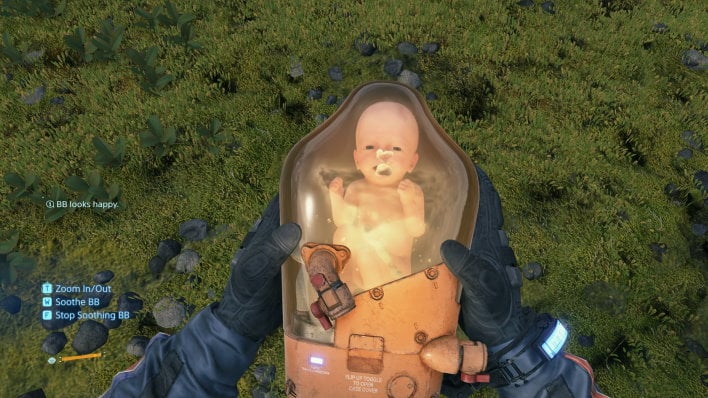
Just like a real baby, the BB requires careful handling. Fall down too much, get attacked by an enemy, or sometimes seemingly for no apparent reason at all, and the BB can get stressed out and enter a state of autotoxicity. Just like Yoshi's Island on the Super Nintendo, the baby cries when it's in a state of stress, and just like Baby Mario it grates on the ears. The only way to deal with a stressed BB is by rocking it. At first, the BB seems like a huge burden, but over time I got sucked into Sam's apparent connection with the child and not carrying it around felt kind of weird.
Lastly, there are some new side quests for the PC release of Death Stranding. In collaboration with Valve, Kojima Productions created six side quests featuring a "familiar face" who impersonates Bridges employees and sends emails prompting Sam to collect a series of Portal Companion Cubes. Completing these missions will provide players with in-game rewards and ultimately expose the "friendly imposter" Sam encounters on his journey.
Multiplayer in Death Stranding is pretty organic and didn't really require interactions with other people. As we traveled around the countryside, we'd occasionally encounter "lost" cargo, which had been entrusted to someone else and ultimately lost. Just playing the game results in receiving "likes", which is a point system that reflects how we interacted with the world. These likes affect how our When we delivered that cargo, we received extra likes, and as a result, Sam became stronger.
If it isn't obvious from these descriptions, Death Stranding really encourages players to approach it with altruistic goals. Helping out our fellow courier resulted in an in-game benefit for our Sam. Placing encouraging signs along the path causes those signs to show up for other players, and they can be encouraged, which in turn would result in more "likes" from others further bolstering our Sam. Death Stranding seems to be a game about unity and helping one another out, but we found our motivations were driven by the stat boost, or a sort of "moral dessert" where good behavior is rewarded in the here and now, which makes the philosophy lesson Kojima seems to be teaching fall a little flat.
PC Options And Console Conversion
Graphically, there are a boatload of options. Death Stranding supports NVIDIA's second-generation Deep Learning Super Sampled (DLSS 2.0) anti-aliasing technique on GeForce RTX GPUs. Radeon fans aren't left out in the cold though, as the game also supports AMD's FidelityFX Contrast Adaptive Sharpening, which minimizes artifacts. Death Stranding runs in a full-screen window mode, so the end resolution is always tied to your desktop's settings, but the engine can render its graphics at a variety of resolutions from 720p to 2160p. Textures, geometry, and shading all have a series of settings available, too, but we stuck to the highest across the board for reasons that will become obvious on the next page. Let's take a look at the system requirements...
|
|
PC Spec |
Minimum (30 fps @720p) |
Recommended (30fps @1080p) |
Recommended (60fps @1080p) |
|
OS |
Windows 10 |
Windows 10 |
Windows 10 |
|
Processor |
Intel Core i5-3470 / |
Intel Core i5-4460 / |
Intel Core i7-3770 / |
|
Memory |
8 GB |
8 GB |
8 GB |
|
Graphics |
NVIDIA GeForce GTX 1050 3 GB / |
NVIDIA GeForce GTX 1050 Ti 4 GB / |
NVIDIA GeForce GTX 1060 6 GB / |
|
DirectX |
DX12 |
DX12 |
DX12 |
|
Storage |
80 GB |
80 GB |
80 GB |
|
Audio |
DirectX Compatible |
DirectX Compatible |
DirectX Compatible |
The CPU requirements are pretty light, and it seems that a lot of hardware threads or even new CPUs aren't really necessary. Anything in today's CPUs from around $150 on up should be more than sufficient. That includes a Core i5-9400F and a Ryzen 5 3600. In graphics cards, it's roughly the same: our own testing has shown that a $150 GeForce GTX 1650 is around 30% faster than a GeForce GTX 1050 Ti, and if the slower Pascal card is good enough for 1080p at 30 fps, then the smallest Turing should be more than adequate. Much of this likely stems from the console port nature of the game, and the base PS4 Slim is based on ancient (at this point) first-gen GCN and AMD Bobcat cores.
As with any game that was initially a console-exclusive there are always concerns among PC gamers about how well it was ported to the most powerful and configurable gaming platform. This is especially true when it comes to controls, because consoles are limited to gamepads on consoles, when a mouse and keyboard are more precise and comfortable on a PC. If a game doesn't play well with a mouse and keyboard, that can kill the experience for a lot of folks, so in our testing we spent the majority of our time playing on a Corsair Strafe Mk. II and M65 Elite, but did check out how it handles with an Xbox One controller, too.
Death Stranding was obviously made for playing with a controller; the game has mouse and keyboard controls, but they're kind of rough. Like most third-person player characters, Sam looks around with the mouse and walks with the WASD keys. When running around and falling over, Sam can re-center his balance via the mouse buttons. Everything else is on the keyboard, and most keys are easily reached. However, finding a waypoint or your next destination requires pressing G, which is a little awkward when you're walking with W already. Combat is a bit difficult, as well, as the main key on the keyboard to both dodge BTs and melee attack MULEs and Terrorists is V, which is incredibly awkward and hard to find in the middle of the action, especially when you're trying to run away.
Because of the limited number of buttons on a controller, other actions are awkward too, even if you're using a keyboard. Activating a terminal requires holding a button for a few seconds, instead of a simple tap. Early on, we stood around and waited for nothing to happen, because it's just not natural to hold a button. The user interface could use a little streamlining, too. As we mentioned above, cut scenes replay over and over as we made deliveries. What's worse is you have to wait for those scenes to finish (or click like a crazy person to skip through them) and then walk through the result screen. We're not sure why this couldn't just be a combination of the results and a skippable voiceover. That's not a PC or PS4 issue, either, since it happens on both.
Now that we've talked about the game a bit and dug into the PC port's goodies, let's see how it runs.


